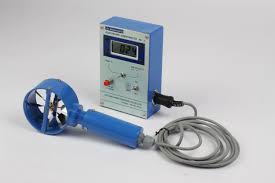Air Flow Measurement Procedure
Reference standard for these instruction are CTI ATC 143
Air Flow –
is the amount of air movement across a plan. The primary cause of airflow is the existence of pressure gradients which directly related to altitude, temperature, and composition. Airflow is created by the natural means of wind and circulation, or it can be created artificially by the mechanical means of a fan or blower unit.
Instrument for flow measurement -
There are two basic instruments for airflow testing of cooling towers: Anemometer or Pitot tube. The purpose of each is to measure the velocity at a point. After a number of points are measured to obtain a representative or average velocity. The total airflow is calculated using the net discharge area of the fan.
Anemometer –
is a device for measuring speed of air, for different application various type of anemometer are use but for fan airflow measurement mainly vane type anemometer is used which basically a calibrated propeller. Speed of the rotating vane of the anemometer is converted into electric power, which is converted into the passing air speed.
Where to Measure – Measurement of flow can be exercise at any plan of the flow path but to avoid any miss representation due to leakage it is a better practice to measure flow closest to the fan it can also be measured at succession or delivery but it should cover the entire path of air without any disturbance by measuring team. And also safety of instrument and human should be kept in mind.
So in general it is a common practice to measure air flow at delivery side.
For air flow calculation we need net free area at plan of measurement, it is area from where flow passes in this be consider the total area of the casing/fan ring and remove the area of any blockage in the flow path it could be hub, beam or any additional structure available on measuring plan.
Net free area is -
Net Area = Casing Area – Hub Area or Aerodynamic hub/Seal Disc whichever is higher
Calculate point of measurement
For air velocity sample reading – it is recommended to have ring (also known as equal area band) in each of four quadrants in the measuring plan. Minimum number of points for a fan would be 20, four points in each of 5 equal area bands. A typical air-flow test requires measuring velocity at the centre of each equal area bands in four quadrants. If fans are more than 20 ft. diameter, 10 equal area bands should be considered. Up to 20 ft. fan we need 5 equal area Band in Four Quadrants i.e. 20 reading. Above 20 ft. fan we need 10 equal area Band in Four Quadrants i.e. 40 reading.
Heading Sample 2
Vivamus imperdiet condimentum diam, eget placerat felis consectetur id. Donec eget orci metus, ac adipiscing nunc. Pellentesque fermentum, ante ac interdum ac adipiscing nunc. Vivamus imperdiet condimentum diam, eget placerat felis consectetur id. Pellentesque fermentum, ante ac interdum id. Donec eget orci metus, ac adipiscing nunc. Pellentesque fermentum, ante ac interdum ullamcorper.
Heading Sample 3
 Vivamus imperdiet condimentum diam, eget placerat felis consectetur id. Donec eget orci metus, Vivamus imperdiet condimentum diam, eget placerat felis consectetur id. Donec eget orci metus, ac adipiscing nunc. Pellentesque fermentum, ante ac interdum ullamcorper. Donec eget orci metus, ac adipiscing nunc. Pellentesque fermentum, consectetur id. Donec eget orci metus, ac adipiscing nunc. Pellentesque fermentum, ante ac interdum ullamcorper. Donec eget orci metus, ac adipiscing nunc. Pellentesque fermentum, ante ac interdum ullamcorper.
Vivamus imperdiet condimentum diam, eget placerat felis consectetur id. Donec eget orci metus, Vivamus imperdiet condimentum diam, eget placerat felis consectetur id. Donec eget orci metus, ac adipiscing nunc. Pellentesque fermentum, ante ac interdum ullamcorper. Donec eget orci metus, ac adipiscing nunc. Pellentesque fermentum, consectetur id. Donec eget orci metus, ac adipiscing nunc. Pellentesque fermentum, ante ac interdum ullamcorper. Donec eget orci metus, ac adipiscing nunc. Pellentesque fermentum, ante ac interdum ullamcorper.
